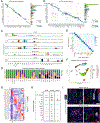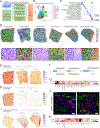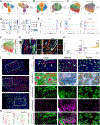Transcriptomic, epigenomic, and spatial metabolomic cell profiling redefines regional human kidney anatomy
- PMID: 38513647
- PMCID: PMC11081846
- DOI: 10.1016/j.cmet.2024.02.015
Transcriptomic, epigenomic, and spatial metabolomic cell profiling redefines regional human kidney anatomy
Abstract
A large-scale multimodal atlas that includes major kidney regions is lacking. Here, we employed simultaneous high-throughput single-cell ATAC/RNA sequencing (SHARE-seq) and spatially resolved metabolomics to profile 54 human samples from distinct kidney anatomical regions. We generated transcriptomes of 446,267 cells and chromatin accessibility profiles of 401,875 cells and developed a package to analyze 408,218 spatially resolved metabolomes. We find that the same cell type, including thin limb, thick ascending limb loop of Henle and principal cells, display distinct transcriptomic, chromatin accessibility, and metabolomic signatures, depending on anatomic location. Surveying metabolism-associated gene profiles revealed non-overlapping metabolic signatures between nephron segments and dysregulated lipid metabolism in diseased proximal tubule (PT) cells. Integrating multimodal omics with clinical data identified PLEKHA1 as a disease marker, and its in vitro knockdown increased gene expression in PT differentiation, suggesting possible pathogenic roles. This study highlights previously underrepresented cellular heterogeneity underlying the human kidney anatomy.
Keywords: MALDI-MS; SHARE-seq; acute kidney injury; anatomy; chronic kidney disease; lipid metabolism; metabolism; multiomics; single-cell combinatorial indexing; spatial metabolomics.
Copyright © 2024 The Authors. Published by Elsevier Inc. All rights reserved.
Conflict of interest statement
Declaration of interests B.D.H. is a consultant for Janssen Research & Development, LLC, Pfizer, and Chinook Therapeutics, held equity in Chinook Therapeutics and grant funding from Chinook Therapeutics, Pfizer and Janssen Research & Development, LLC; all interests are unrelated to the current work.
Figures







References
Publication types
MeSH terms
Grants and funding
LinkOut - more resources
Full Text Sources
Molecular Biology Databases

